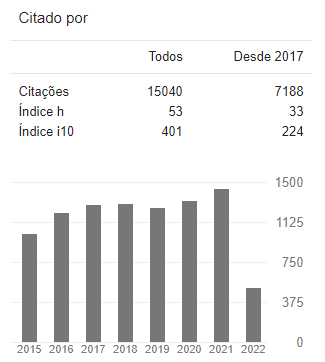Increasing physical activity by Gamification among Brazilian high school students: a pilot study
DOI:
https://doi.org/10.12820/rbafs.26e0230Palavras-chave:
Smartphone, Atividade física, AdolescentesResumo
Este estudo piloto teve como objetivo avaliar a eficácia de uma intervenção baseada em gamificação nos níveis de atividade física de alunos do ensino médio. Este estudo quase-experimental foi realizado em duas escolas federais de ensino médio no sul do Brasil. Uma turma de cada escola foi selecionada para ser um grupo de intervenção (INT) ou controle (CON). A duração do experimento foi de duas semanas, e ambos os grupos baixaram o aplicativo My Active Life. Os participantes do grupo INT (n = 69) receberam alertas diários no app com mensagens de incentivo à prática de atividade física. Eles também receberam uma pontuação com base no percentual de meta alcançada. O grupo CON (n = 35) só teve acesso ao número total de passos por dia. O grupo INT apresentou menor diminuição da atividade física na escola em comparação ao grupo CON (p = 0,024). Nenhum efeito da intervenção foi observado na atividade física fora da escola (p = 0,911). A intervenção baseada na gamificação evitou uma diminuição da atividade física na escola entre meninos (F = 10,680; p = 0,004), alunos na primeira metade do ensino médio (F = 12,668; p = 0,002) e índice de massa corporal adequado (F = 4,640; p = 0,037), e com menor percepção de barreiras à atividade física (F = 5,437; p = 0,024). Embora não tenhamos observado aumento da atividade física na escola, a intervenção baseada na gamificação pode atenuar sua diminuição entre os adolescentes.
Downloads
Referências
Humphreys BR, McLeod L, Ruseski JE. Physical activity and health outcomes: Evidence from Canada. Health Econ (United Kingdom). 2014;23:33–54.
Wicker P, Coates D, Breuer C. Physical activity and subjective well-being: the role of time. Eur. J. Public Health. 2015;25:864–8.
Chau MM, Burgermaster M, Mamykina L. The use of social media in nutrition interventions for adolescents and young adults-A systematic review. Int J Med Inform. 2018;120:77–91.
Haruna H, Hu X, Chu SKW, Mellecker RR, Gabriel G, Ndekao PS. Improving Sexual Health Education Programs for Adolescent Students through Game-Based Learning and Gamification. Int J Environ Res Public Health. 2018;15(9):2027.
Kim SE, Kim JW, Jee YS. Relationship between smartphone addiction and physical activity in Chinese international students in Korea. J. Behav. Addict. 2015;4:200–5.
Mok JY, Choi SW, Kim DJ, Choi JS, Lee J, Ahn H, et al. Latent class analysis on internet and smartphone addiction in college students. Neuropsychiatr. Dis. Treat. 2014;10:817–27.
Iannotti RJ, Kogan MD, Janssen I, Boyce WF. Patterns of Adolescent Physical Activity, Screen-Based Media Use, and Positive and Negative Health Indicators in the U.S. and Canada. J. Adolesc. Health. 2009;44:493–9.
Iannotti RJ, Wang J. Patterns of physical activity, sedentary behavior, and diet in U.S. adolescents. J. Adolesc. Health. 2013;53:280–6.
Sardi L, Idri A, Fernández-Alemán JL. A systematic review of gamification in e-Health. Vol. 71, Journal of Biomedical Informatics. Academic Press Inc.; 2017. p. 31–48.
Cugelman B. Gamification: what it is and why it matters to digital health behavior change developers. JMIR Serious Games. 2013;1:e3.
Cesa GL, Manzoni GM, Bacchetta M, Castelnuovo G, Conti S, Gaggioli A, et al. Virtual reality for enhancing the cognitive behavioral treatment of obesity with binge eating disorder: Randomized controlled study with one-year follow-up. J Med Internet Res. 2013;15:e113.
Staiano AE, Calvert SL. Exergames for Physical Education Courses: Physical, Social, and Cognitive Benefits. Child Dev. Perspect. 2011;5:93–8.
Althoff T, White RW, Horvitz E. Influence of Pokémon Go on Physical Activity: Study and Implications. J Med Internet Res. 2016;18:e315.
Harris MA. The relationship between physical inactivity and mental wellbeing: Findings from a gamification-based community-wide physical activity intervention. Health Psychol. Open. 2018;5:2055102917753853.
Patel MS, Benjamin EJ, Volpp KG, Fox CS, Small DS, Massaro JM, et al. Effect of a game-based intervention designed to enhance social incentives to increase physical activity among families: The BE FIT randomized clinical trial. JAMA. 2017;177:1586–93.
Pandian JD, Gall SL, Kate MP, Silva GS, Akinyemi RO, Ovbiagele BI, et al. Prevention of stroke: a global perspective. Vol. 392, The Lancet. Lancet Publishing Group; 2018. p. 1269–78.
Oliveira MM, Campos MO, Andreazzi MAR de, Malta DC, Oliveira MM de, Campos MO, et al. Características da Pesquisa Nacional de Saúde do Escolar - PeNSE. Epidemiol. Serv. Saude. 2017;26:605–16.
Santos MS, Reis RS, Rodriguez-Añez CR, Fermino RC. Desenvolvimento de um instrumento para avaliar barreiras para aprática de atividade física em adolescentes. Rev Bras Ativ Fís Saúde. 2009;14:76–85.
Fermino RC, Rech CR, Hino AA, Rodriguez Añez CR, Reis RS. Physical activity and associated factors in high-school adolescents in Southern Brazil. Rev Saude Publica. 2010;44(6):986-95.
Farias Júnior JC, Lopes Ada S, Mota J, Hallal PC. Physical activity practice and associated factors in adolescents in Northeastern Brazil. Rev Saude Publica. 2012 Jun;46(3):505-15.
Bann D, Scholes S, Fluharty M, Shure N. Adolescents’ physical activity: Cross-national comparisons of levels, distributions and disparities across 52 countries. Int. J. Behav. Nutr. Phys. Act. 2019;16:1–11.
HHS. Physical Activity Guidelines for Americans 2 nd edition.
Santos MS, Hino AA, Reis RS, Rodriguez-Añez CR. Prevalência de barreiras para a prática de atividade física em adolescentes. Rev Bras Epidemiol. 2010;13(1):94-104.
Mo D, Xiang M, Luo M, Dong Y, Fang Y, Zhang S, et al. Using gamification and social incentives to increase physical activity and related social cognition among undergraduate students in Shanghai, China. Int. J. Environ. Res. 2019;16.
Edney SM, Olds TS, Ryan JC, Vandelanotte C, Plotnikoff RC, Curtis RG, et al. A Social Networking and Gamified App to Increase Physical Activity: Cluster RCT. Am. J. Prev. Med. 2020;58:e51–62.
Corepal R, Best P, O’Neill R, Kee F, Badham J, Dunne L, et al. A feasibility study of “The StepSmart Challenge” to promote physical activity in adolescents. Pilot Feasibility Stud. 2019;5.
Corepal R, Best P, Tully MA, Edwards M, Jago R, Miller SJ, et al. Exploring the use of a gamified intervention for encouraging physical activity in adolescents: a qualitative longitudinal study in Northern Ireland. BMJ Open. 2018;0:19663.
Coombes E, Jones A. Gamification of active travel to school: A pilot evaluation of the Beat the Street physical activity intervention. Health Place. 2016;39:62–9.
Shameli A, Althoff T, Saberi A, Leskovec J. How gamification affects physical activity: Large-scale analysis of walking challenges in a mobile application. In: 26th International World Wide Web Conference 2017, WWW 2017 Companion. New York, New York, USA: International World Wide Web Conferences Steering Committee; 2019. p. 455–63.
Ahn SJ (Grace), Johnsen K, Ball C. Points-Based Reward Systems in Gamification Impact Children’s Physical Activity Strategies and Psychological Needs. Health Educ. Behav. 2019;46:417–25.
Pope L, Garnett B, Dibble M. Lessons Learned Through the Implementation of an eHealth Physical Activity Gaming Intervention with High School Youth. Games Health J. 2018;7:136–42.
Downloads
Publicado
Como Citar
Edição
Seção
Licença
Copyright (c) 2021 Revista Brasileira de Atividade Física & Saúde

Este trabalho está licenciado sob uma licença Creative Commons Attribution 4.0 International License.










